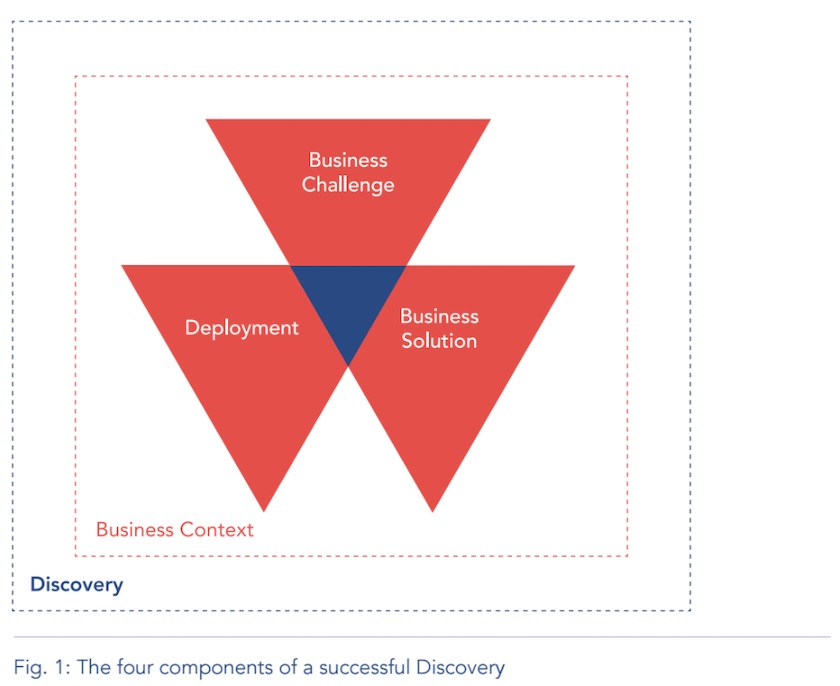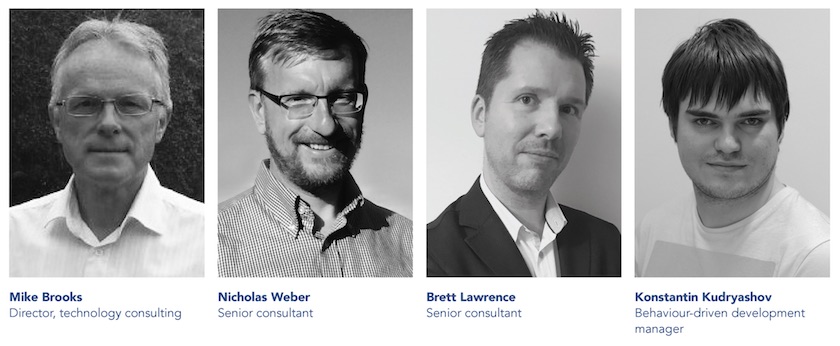Ensuring a return on investment in digital projects
Technology is proving to be a game-changer in the quest to reach audiences in fresh and engaging ways. It’s little surprise then that companies are looking to drive business growth by investing in digital.
Introduction
Whatever the nature of your business, and the challenges it faces, it’s likely that you’ll need to demonstrate tangible return on any digital investment – whether it’s a new ecommerce channel, a next-generation content management system, or a mobile application.
Worryingly though, many organisations launch into their digital projects with a predetermined set of requirements often based on the failings of an existing digital solution. As a result they often lack a well-defined strategy and understanding of how a digital initiative supports an agreed, measurable business objective.
The Discovery – a series of workshops designed to identify the simplest way of addressing a business challenge – is a compelling way to prime your digital initiative for success by ensuring your business objectives are realised through an appropriate digital investment.
At Inviqa, a web and software development company, our consultancy practice has developed a proven and unique approach to Discovery that establishes a healthy, collaborative partnership between key business stakeholders, product owners, and technologists that ensures a better understanding of the business challenge, an approach to deployment that minimises business risk, and the scope of work ahead.
This whitepaper describes the Inviqa Discovery process and how it helps to ensure you realise business value in your digital projects. It identifies four components of a successful Discovery that can be adapted to serve your unique needs and help deliver return on your digital investment – whatever the nature of your business or your goals.
The role of Discovery within an RFP process
Many companies opt for the request for proposal (RFP) process as a systematic way to get consistent responses from different suppliers at the outset of a digital project. All suppliers receive the same information, questions, and timeframes within which to respond.
This is valid when procuring straightforward services and commodities where a key objective of the process is often to arrive at the lowest price. But when the end solution is far more nuanced, it drives the focus of the exercise towards procuring features instead of collaboratively exploring value generation and the most effective way to use the budget.
It does this by starting with an assumed answer in the absence of any concept of value. There’s rarely a clear view on whether the requested features will generate any value, and the RFP may incorporate features that have not delivered value historically, but are included ‘because the business has always done things that way’.
This builds waste into the project and means requested features could be competing for budget against potentially far more worthwhile features that haven’t been considered because the concept of value is missing.
The need to evaluate other options before jumping into the Discovery process is understandable. But launching into a full RFP process too often means prescribing an answer and inviting conversation around features per pound, rather than value for budget.
There are far better ways to gain confidence in a potential technology partner than a full RFP from the outset. This can be achieved using a partner selection process focused on the likes of track record, industry experience, and cultural fit. Once that’s been done, the process of deliberate, collaborative, and value-driven Discovery should begin.
There are far better ways to gain confidence in a potential technology partner than a full RFP from the outset.
The Discovery in a nutshell
When it comes to digital investment, the Discovery’s role is to identify the simplest way of addressing a business challenge in the shortest-possible timeframe. Whether you’re investing in a new digital solution, or extending an existing one, the Discovery process aims to find the easiest and most effective way of realising your business objective.
Discovery allows you to understand the range of possible options open to your business through an assessment of key influences, constraints, and opportunities. These options can then be explored in depth to arrive at a minimum viable product. In other words, the most basic commercially-viable digital solution that achieves your business objective – in the fastest-possible time. This establishes a base from which to further enhance your solution whilst also enabling you to quickly start delivering return on investment.
Of course no two Discoveries are exactly alike, because each company has a different context that will shape how that Discovery will unfold. Every company is at a different stage in their own digital journey. Some will have a long track record of digital innovation and will have clarity on what they’re looking for. Others may be embarking on their first significant investment in a digital channel or solution.
Whatever the nature of your business and its goals, the Discovery process must address four fundamental considerations: the business context, the nature of the business challenge, the business solution that will meet this challenge, and the optimum approach to deployment in creating the digital solution. This model is illustrated in Figure 1.
Although each of the steps in the Discovery process is described below as a sequence, the reality is that there’s a high degree of interplay between the steps. In practice, the Discovery takes the shape of several cycles of refinement. Each step surfaces more options and considerations that are used to achieve alignment between all parties on the most effective way of responding to a given business challenge.

The 4 components of a successful Discovery
1. Business context
Responding to any business challenge requires an appreciation of business context: the factors that will influence how to identify and frame opportunities, constraints, and risks. Understanding this business context ultimately helps identify the options from which a preferred approach can be agreed.
The business context component is key to avoiding some of the pitfalls that can derail a digital project. There are frequently widerbusiness issues and operational models that need to be considered during the Discovery process so you don’t uncover nasty surprises during the implementation phase.
Four questions to ask yourself about business context:
1. What wider business initiatives could affect your options?
Digital projects are rarely commissioned in isolation – they form part of an ongoing drive to improve business performance. Often an individual project is part of a wider initiative and is informed and influenced by a broader business strategy. Such wider business activities could present opportunities or constraints that need to be considered.
2. How will this project impact your current and future operating model?
From an operational perspective, understanding your current and future operating model will surface additional considerations. Too often digital solutions reflect operating practices which in themselves are not optimal. But simple changes to improve or adapt your operational processes can often be uncovered during a Discovery and deliver business benefit before any further investment in a digital solution is made.
3. How does the nature of your business sector influence your approach?
Your business sector determines what type of target audience you’re after. Understanding how to satisfy and influence the expectations of your target audience will clearly impact the nature of any digital solution. A very fast-paced industry where customer and competitive demands change quickly, will demand a very fast time to market; business sectors with high degrees of digital integration will present technical complexities.
4. Who are the stakeholders that need to be considered for this project?
There will always be people with a vested interest in the outcome of a project, or whose actions can impact the success of your outcome. It’s important to collaborate with these stakeholders from the outset so that their views, interests, and motivations are taken into account. Most digital solutions need to evoke interaction with a critical stakeholder: the user (or customer). Taking time to explore user behaviour before landing on a specific solution is a critical part of the Discovery process. After all, a software solution built in isolation from those whose problem it tries to solve is useless.
Software alone cannot bring businesses closer to their objectives – people using it can. Software is an enabler, not a solution. Without understanding how software should or could impact its users, one cannot hope to be effective at delivering that software successfully.
2. Business challenge
Having clarified the business context, the focus moves onto collaboratively exploring the specifics: the business challenge, and a clear and concise view of both the business objective(s) to be realised and the stakeholder behaviours that will influence your ability to achieve these objectives.
If your challenge is growth in an increasingly competitive market, your business objective (at a high level) might be to ‘increase revenue’, and ‘reduce product returns’ (at a more granular level). Whatever your business objectives, it’s critical that it can be measured. If you can’t measure it, you can’t quantify your ability to impact the business challenge (and your success in doing so).
Some organisations are convinced of the value provided by having a hierarchy of key performance indicators (KPIs) to measure and drive business performance. Others, meanwhile, are comfortable with performance measured at the ‘top line’ only. In reality, the greater the clarity around the business objective, the easier it will be to identify the behaviours that will help realise this objective.
3. Business solution
The question at this stage is whether a business solution, capable of meeting the agreed business objective, can be achieved through technology. And if so, what is the simplest and most effective digital solution for achieving your business objective?
The workshop process will ultimately yield a list of top-level, non-prioritised features that could potentially be combined to create a digital product or solution. This is the stage where many technology projects fail to meet expectations. It’s easy to fall into the trap of assuming that all the features you identify are required – and that they’re all key to realising the business objective. The Discovery process helps you avoid this by always ensuring your business objective is the driving force in determining how to prioritise your features.
When prioritising features, it’s critical to put business value first, avoiding ‘vanity’ initiatives, and looking to build with long-term benefit in mind. Avoid an approach so committed and rigid that your product cannot react to changes within your business or marketplace. The focus should remain on delivering features that provide real value and traction towards your business goals.
4. Deployment plan
A Discovery performed well should shape an execution strategy that maximises early business value and minimises risk. The first instance of this is the minimum viable product (MVP), which is defined during the Discovery process. You then need to consider how to implement this through a design and build stage.
Deploying any digital solution is challenging. Whether you’re heading for some kind of continuous deployment Nirvana, or you’re simply focussed on the routine, frequent production of a few new features, there are many technical and business considerations to take into account. What’s more, no two projects are the same and each will have its own challenges and risk profile that must be reflected in the approach to deployment.
Today’s myriad of tools in this space presents a veritable minefield for businesses looking for a quick fix for a complex problem. Effective Discovery surfaces the business and technical considerations and some early recommendations on deployment approach, organisation, and tooling.
An important consideration in implementation is the pace of change in technology and the wider business environment where speed-to-market is often critical. Time isn’t money; it’s more valuable than money. It follows then that it’s often more productive to get something out fast and start testing the market, rather than investing significant effort in designing, only to realise that some – or, worst case scenario, all – your assumptions become invalid.
Why use Inviqa’s expertise?
Discoveries tend to be more successful when they are facilitated by an external party. This is true of businesses of all types since external parties can help those businesses remain objective and laser-focused on the strategic goals.
A third party is also especially helpful where an organisation lacks the high level of expertise and experience required to make fully-informed decisions about digital investment. Without the right people, culture, and technical expertise, it can be hard to get your digital initiatives off to the right start.
With Forrester finding that just 16 percent of business executives believe their company has the necessary people and skills to succeed in digital strategy, it’s clear that consultancies and agencies provide a compelling means of overcoming those limitations and establishing the innovative, collaborative environment you need to succeed in your digital journey.
The right partner should have both in-depth technical know-how and a business-objectives-led approach that ensures they never lose sight of your goals. Our consultancy practice at Inviqa, for example, is led by a small team of experts who have held senior positions in major companies leading digital investments ‘client-side’. We pride ourselves on being a technology partner and consultant who really gets inside your business, understands your goals, and helps you to identify the right starting point for your journey.
The Discovery delivered to us by Inviqa proved to be invaluable, and we have since worked it into our project analysis and estimation procedures. It’s ensured we stay focused on clear business value rather than an unsubstantiated list of requirements.
Inviqa helped us to describe our requirements in a clear, unique way that really helped the development team understand the overall aims of the project. This approach, that strategic overview and shared vision of the user benefits was vital.
Summary
The purpose of any Discovery is to create alignment between your product owner, wider business, and technology partner to identify the most appropriate use of technology and approach to implementation.
A successful Discovery should leave you with a blueprint for your project towards an agreed set of goals and objectives, and an approach to achieve them. Typically this should include the identification of risks, approach options, constraints, proposed implementation, complexity, and priority of options.
In our experience at Inviqa, the Discovery phase is invaluable for enabling solutions that meet – and even exceed – expectations. But it’s important to remember that the learning doesn’t stop at the Discovery, and the principles that underpin your Discovery continue to act as the foundations for successful project delivery and beyond.
Contributors






